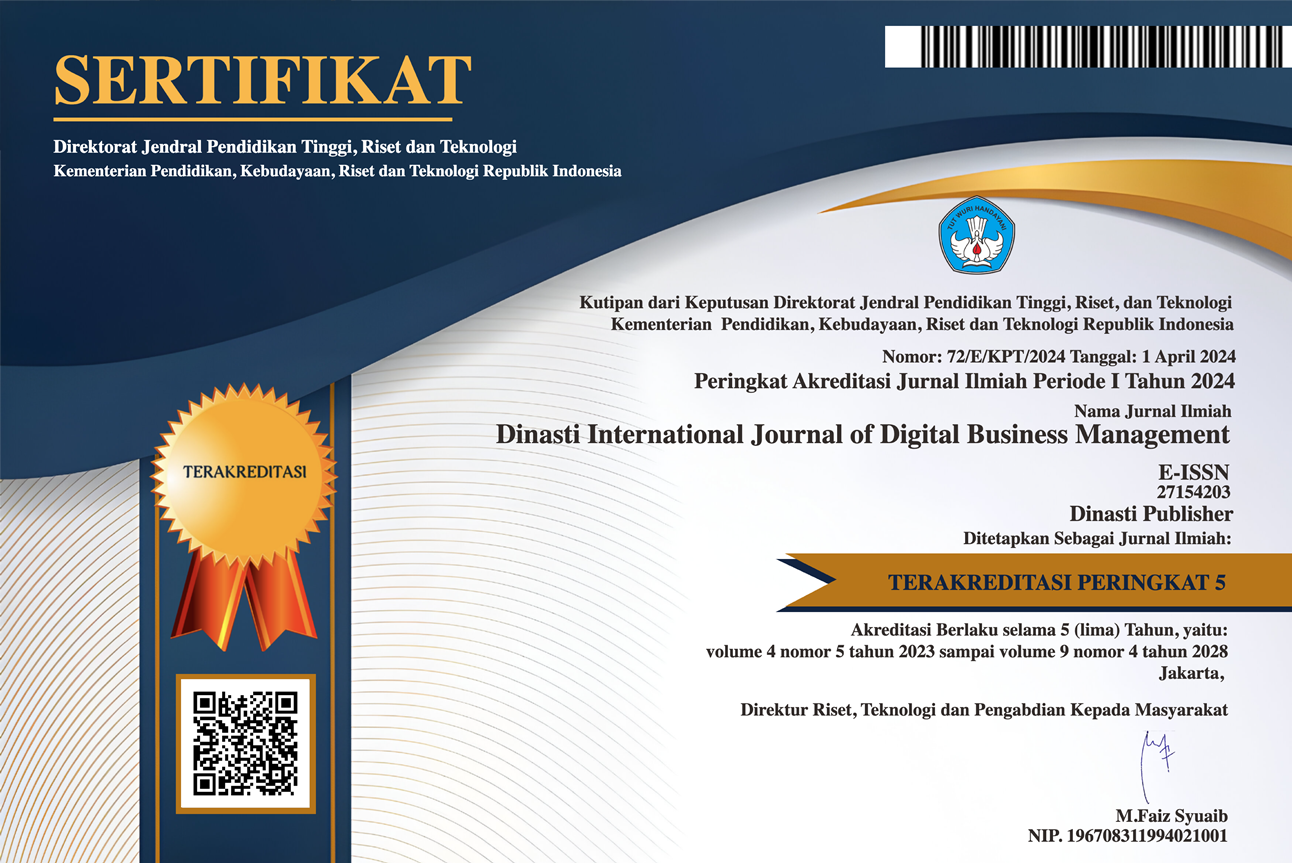How the Mediation Effect of Job Stress on the Relationship between Safety Leadership, Safety Culture and Safety Performance
DOI:
https://doi.org/10.31933/dijdbm.v5i2.2312Keywords:
Job Stress, Safety Culture, Safety Leadership, Safety PerformanceAbstract
Indonesia's mining company's safety performance in the last 2 years has seen a downward trend. The study aims to investigate the mediation effects of job stress on relationships between safety leadership, safety culture and safety performance. The research data is a questionnaire from the production department of coal mining companies in the Eastern Kalimantan Provinces. Sampling method are taken using the proportionate random sampling, with the number of respondents as many as 161 workes. The method of data analysis using of structural equation modelling. The findings of this study suggest that leadership, culture and job stress are having a positive effect on safety performance. The direct influence of safety leadership and the safety culture on safety performance is stronger than through the job stress. The direct influence of safety leadership on the safety performance is more powerful than the influence of the safety culture on the safety performance.References
Antonsen, S. (2009). Safety Culture?: Theory, Method and Improvement. Ashgate.
Armstrong. (2006). A Handbook of Human Resource Management Practice (10th ed.). Kogan Page.
Bentler, P. M., & Chou, C. P. (1987). Practical Issues in Structural Equation Modeling. Sociological Methods & Research, 16(1), 78–117.
Bird Jr, F. E., & Germain, G. L. (1990). Practical Loss Control Leadership. International Loss Control Institute, Inc.
Bollen, K. A. (1989). Structural Equations with Latent Variables. JOHN WILEY & SONS.
Bryne, B. (2010). Structural Equation Modeling with AMOS: Basic Concepts, Applications, and Programming. In Structural Equation Modeling.
Curcuruto, M., Conchie, S. M., Mariani, M. G., & Violante, F. S. (2015). The role of prosocial and proactive safety behaviors in predicting safety performance. Safety Science, 80, 317–323. https://doi.org/10.1016/j.ssci.2015.07.032
Du, X., & Sun, W. (2012). Research on the relationship between safety leadership and safety climate in coalmines. Procedia Engineering, 45(06), 214–219. https://doi.org/10.1016/j.proeng.2012.08.146
Feng, Y., Teo, E. A. L., Ling, F. Y. Y., & Low, S. P. (2014). Exploring the interactive effects of safety investments, safety culture and project hazard on safety performance: An empirical analysis. International Journal of Project Management, 32(6), 932–943. https://doi.org/10.1016/j.ijproman.2013.10.016
Ferdinand, A. (2014). Structural Equation Modeling Dalam Penelitian Manajemen. Badan Penerbit UNDIP.
Flin, R., Mearns, K., O’Connor, P., & Bryden, R. (2000). Measuring safety climate: Identifying the common features. Safety Science, 34(1–3), 177–192. https://doi.org/10.1016/S0925-7535(00)00012-6
Friend, M. A., & Kohn, J. P. (2007). Fundamentals of Occupational Safety and Health. Government Institutes. https://doi.org/10.1016/b978-0-08-010994-7.50030-2
Ghozali, I. (2013a). Aplikasi Analisis Multivariate Dengan Program IBM SPSS 21. Badan Penerbit UNDIP.
Ghozali, I. (2013b). Model Persamaan Struktural, Konsep dan Aplikasi dengan Program AMOS 21.0. Badan Penerbit UNDIP.
Ghozali, I. (2017). Model Persamaan Struktural Konsep dan Aplikasi dengan Program AMOS 24 Update Bayesin SEM (7th ed.). Badan Penerbit Universitas Diponegoro.
Gracia, F. J., Tomás, I., Martínez-Córcoles, M., & Peiró, J. M. (2020). Empowering leadership, mindful organizing and safety performance in a nuclear power plant: A multilevel structural equation model. Safety Science, 123(October 2019), 104542. https://doi.org/10.1016/j.ssci.2019.104542
Griffin, M. A., & Neal, A. (2000). Perceptions of Safety at Work?: A Framework for Linking Safety Climate to Safety Performance , Knowledge , and Motivation. 5, 347–358.
Hair, J. F., Black, W. C., Babin, B. J., & Anderson, R. E. (2014). Multivariate Data Analysis (MVDA). In Pharmaceutical Quality by Design: A Practical Approach. https://doi.org/10.1002/9781118895238.ch8
Huang, Y. hsiang, Sinclair, R. R., Lee, J., McFadden, A. C., Cheung, J. H., & Murphy, L. A. (2018). Does talking the talk matter? Effects of supervisor safety communication and safety climate on long-haul truckers’ safety performance. Accident Analysis and Prevention, 117(February), 357–367. https://doi.org/10.1016/j.aap.2017.09.006
Hughes, P., & Ferrett, E. (2016). Introduction to Health and Safety in Construction Fifth Edition. In Introduction to Health and Safety in Construction. https://doi.org/10.4324/9781315858708
Kvalheim, S. A., & Dahl, Ø. (2016). Safety compliance and safety climate: A repeated cross-sectional study in the oil and gas industry. Journal of Safety Research, 59(08), 33–41. https://doi.org/10.1016/j.jsr.2016.10.006
Latan, H. (2013). Model Persamaan Struktural Teori dan Implementasi AMOS 21.0. Alfabeta.
Liu, X., Huang, G., Huang, H., Wang, S., Xiao, Y., & Chen, W. (2015). Safety climate, safety behavior, and worker injuries in the Chinese manufacturing industry. Safety Science. https://doi.org/10.1016/j.ssci.2015.04.023
Lu, C. S., & Yang, C. S. (2010). Safety leadership and safety behavior in container terminal operations. Safety Science, 48(2), 123–134. https://doi.org/10.1016/j.ssci.2009.05.003
Mohammadi, A., Tavakolan, M., & Khosravi, Y. (2018). Factors influencing safety performance on construction projects: A review. Safety Science, 109(October 2016), 382–397. https://doi.org/10.1016/j.ssci.2018.06.017
Nunnally, J. C., & Bernstein, I. H. (1994). Psychometric Theory Third Edition. McGraw-Hili, Inc. https://doi.org/34567890 DOCmoC 998765 ISBN
Reese, C. D. (2012). Accident / Incident Prevention Techniques.
Sanusi, A. (2017). Metodolgi Penelitian Bisnis. Penerbit Salemba Empat.
Seo, H. C., Lee, Y. S., Kim, J. J., & Jee, N. Y. (2015). Analyzing safety behaviors of temporary construction workers using structural equation modeling. Safety Science, 77(10), 160–168. https://doi.org/10.1016/j.ssci.2015.03.010
Sherif Mohamed. (2002). Safety climate in the construction site environments. Journal of Construction Engineering and Management, 9364(November), 11. https://doi.org/10.1061/(ASCE)0733-9364(2002)128
Singh, V., Kumar Sharma, S., Chadha, I., & Singh, T. (2019). Investigating the moderating effects of multi group on safety performance: The case of civil aviation. Case Studies on Transport Policy, 7(2), 477–488. https://doi.org/10.1016/j.cstp.2019.01.002
Siu, O. L., Phillips, D. R., & Leung, T. wing. (2004). Safety climate and safety performance among construction workers in Hong Kong: The role of psychological strains as mediators. Accident Analysis and Prevention, 36(3), 359–366. https://doi.org/10.1016/S0001-4575(03)00016-2
Skeepers, N. C., & Mbohwa, C. (2015). A Study on the Leadership Behaviour, Safety Leadership and Safety Performance in the Construction Industry in South Africa. Procedia Manufacturing, 4(Iess), 10–16. https://doi.org/10.1016/j.promfg.2015.11.008
Stemn, E., Bofinger, C., Cliff, D., & Hassall, N. E. (2019). Examining the relationship between safety culture maturity and safety performance of the mining industry. Safety Science, 113, 345–355.
Wu, T. C., Chen, C. H., & Li, C. C. (2008). A correlation among safety leadership, safety climate and safety performance. Journal of Loss Prevention in the Process Industries, 21(3), 307–318. https://doi.org/10.1016/j.jlp.2007.11.001
Wu, X., Liu, Q., Zhang, L., Skibniewski, M. J., & Wang, Y. (2015). Prospective safety performance evaluation on construction sites. Accident Analysis and Prevention, 78, 58–72. https://doi.org/10.1016/j.aap.2015.02.003
Xia, N., Xie, Q., Hu, X., Wang, X., & Meng, H. (2020). A dual perspective on risk perception and its effect on safety behavior: A moderated mediation model of safety motivation, and supervisor’s and coworkers’ safety climate. Accident Analysis and Prevention, 134(October 2019), 105350. https://doi.org/10.1016/j.aap.2019.105350
Downloads
Published
Issue
Section
License
Copyright (c) 2024 Supardi Supardi, Dian Sudiantini

This work is licensed under a Creative Commons Attribution 4.0 International License.
Authors who publish their manuscripts in this journal agree to the following conditions:
- The copyright on each article belongs to the author(s).
- The author acknowledges that the Dinasti International Journal of Digital Business Management (DIJDBM) has the right to be the first to publish with a Creative Commons Attribution 4.0 International license (Attribution 4.0 International (CC BY 4.0).
- Authors can submit articles separately, arrange for the non-exclusive distribution of manuscripts that have been published in this journal into other versions (e.g., sent to the author's institutional repository, publication into books, etc.), by acknowledging that the manuscript has been published for the first time in the Dinasti International Journal of Digital Business Management (DIJDBM).















































